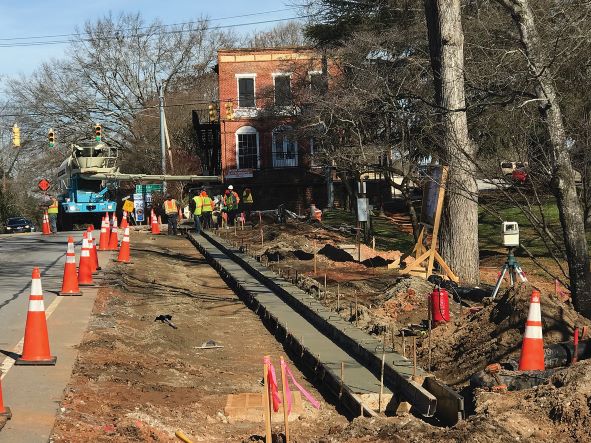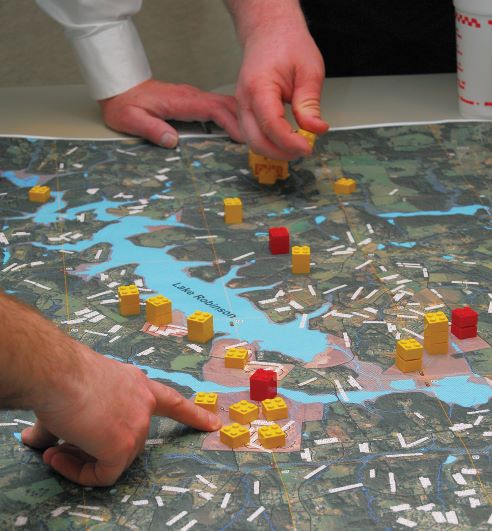Many leaders would prefer a growing city over a stagnant one, but that doesn’t mean growth is simple for municipalities to navigate — particularly when it happens quickly in cities that may not be ready for an increase of buildings and residents.
The Town of Pendleton is one such hotspot. Steven Miller has served as its town administrator for nearly 10 years.
“Right now, we’re having a massive amount of growth, and we’re having some difficulties dealing with it. It’s not always easy all the time with all the subdivisions going in,” Miller said. “Part of it is just coping with the amount of change when it’s coming fast. [For example], how are you going to get enough personnel and equipment in to handle 1,500 more homes in the next five years?”
That sentiment is echoed by Shane Sligh, the town administrator in Pageland, where growth is spilling in from nearby Charlotte and Monroe, N.C.
“We’ve had quite a few growing pains, that will be the first thing I’ll say,” he said.
Many small cities and towns around South Carolina have seen rapid growth, fueled by new industries moving in, the addition of remote workers who want to live in smaller communities or new residents who are willing to commute to nearby cities. In many instances, that combination translates into a need for housing developments, roads, utilities and other services.

Crews install streetscape enhancements along North Mechanic Street in Pendleton.
Photo: Town of Pendleton.
Growth can pump in more resources, but also puts more pressure on municipalities. And a key for managing the growth involves understanding how to plan for it – including land-use management and staffing in municipal offices.
In Pendleton, located in Anderson County in the bustling Upstate, large manufacturing facilities are located in or just outside of town. One of those, Arthrex Manufacturing, expects to add 2,500 employees in the next two or three years, with plans for the campus to grow to 9,000 workers in the next 20 to 30 years.
With an attractive downtown and easy access to Interstate 85, Pendleton is also close to Clemson University and is home to a Tri-County Technical College campus. Parts of the town are bordered by thousands of acres of protected land, locking in development. And while the town is still small, it is clearly growing. The population jumped from 2,800 to 3,400 in the most recent census, but with roughly 30 building permits issued each month, Miller estimated the population is around 4,000 now.
Pendleton has addressed the growth by contracting out some services and attracting, hiring and retaining a capable municipal workforce. The town, which has about 30 full-time employees, also brings in consultants for temporary work, including developing a large tax incremental financing district. Pendleton is preparing to put out a bid to rewrite all of its development ordinances, updating the regulations to make it a performance-based Unified Development Ordinance system.
A few years ago, Pendleton contracted out its wastewater treatment operation to ClearWater Solutions, something Miller called “the best thing we’ve ever done.”
The city also contracts out its key employee recruitment process, hiring an outside human resources firm to find candidates for top positions. It also helps that the council has made employees’ pay competitive with much larger towns so it has been able to hold on to employees, something Miller credits as “a key to our success.”
“We have people with a lot of knowledge on planning boards and committees. We actually have a full-time planner here, which most cities our size do not have. And we have an ongoing contract with a planning consultant who also is a landscape architect, too. So he can talk about design, which makes our boards feel a whole lot more comfortable,” he said.
Another Upstate city, Greer, has seen explosive growth over the past two decades, as the BMW plant and its suppliers, along with other international corporations, expand their workforces, City Administrator Andrew Merriman said.
The city’s planning and zoning office is currently creating a Unified Development Ordinance, updating zoning ordinances and subdivision regulations to address growth. It also works on smart growth strategies such as mixed-use development, creating walkable neighborhoods through sidewalks and trails, creating a range of housing options and preserving green space for recreational opportunities. Greer has had two years of record housing construction since the 2020 census, which marked the population at 35,308.
“Greer City Council understands that we are a service industry and has approved expanded and new full-time and part-time positions to stay ahead of the growth. This is particularly important for emergency services as our residential construction and population expand. The city’s annual budget is directly tied to our growth,” Merriman said.

A planning exercise in Greer envisions the nature of future development around
Lake Robinson. Greer has been home to significant growth in recent decades.
Photo: City of Greer.
Pageland, a town of 2,456 people as of 2020, is experiencing an influx of new residents who are either working from home or commuting to the Charlotte and Monroe, N.C. areas.
“Everything’s wanting to come in and we’re trying to manage all of that,” Sligh said. “Some of what we’re managing is, ‘where’s the money coming from for us to provide additional services?’”
The town is completing a study to determine what type of impact fees it can apply to provide services for the new developments. While there is a new wastewater treatment plant, Pageland also studying the need to increase its water capacity, he said.
The town will also contract out a parks and recreation master plan to determine if Pageland needs more parks or equipment.
Each of the three municipalities has advice for cities dealing with growth — and growing pains.
In Greer, Merriman noted that it’s “important to plan and prepare for growth before it arrives. Bringing partners to the table keeps stakeholders on the same page and permits growth for the best interest of all.”
In Pageland, Sligh stressed the importance of working through the process diligently and patiently.
“Make sure you’re doing what’s right for the community. Not because it’s on your doorstep, but because it is what’s right for the community,” he said.
In Pendleton, Miller noted the importance of bringing in consultants to talk through issues and also building relationships with county leaders and the area’s state legislative delegation, something that is especially important with large projects and road funding. He also advised investing in staff and finding knowledgeable employees who are able to help elected officials understand the decisions they have to make.
“We’re beside the City of Clemson, which is a much larger jurisdiction,” Miller said. “Our joke here is that whatever Clemson did six months ago, we’ll have to do in six months. So, if you have somebody that’s much bigger and has grown faster than you, you can look at what they did through certain times and get an idea of what’s going to happen to you.”
